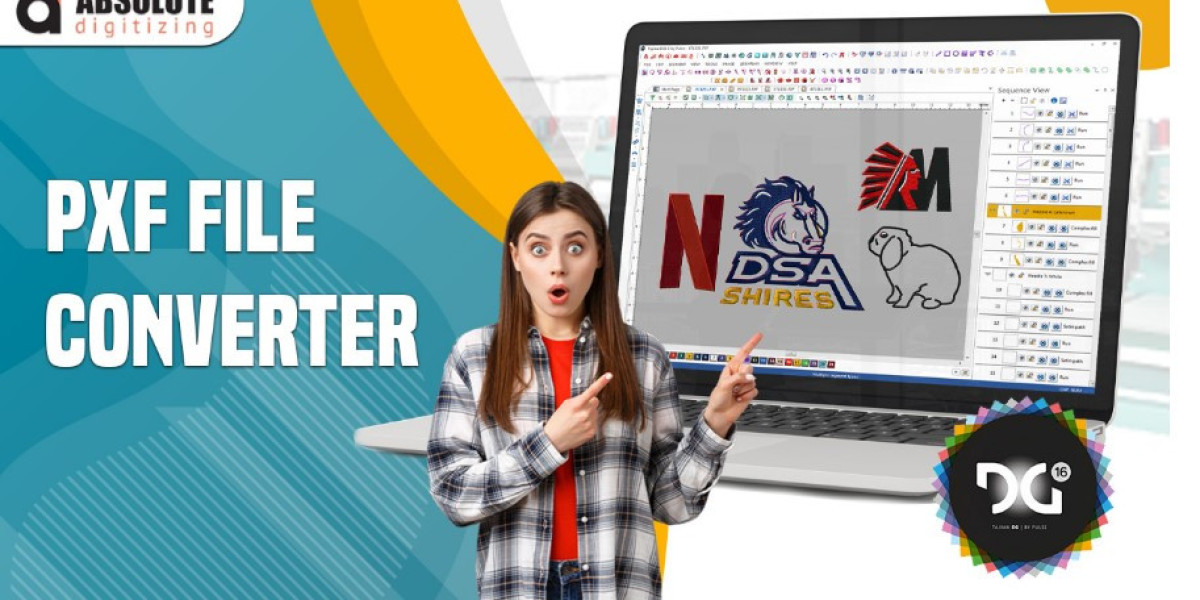Introduction
Embroidery is no longer just a hobby, it's a growing trend in the fashion and branding industries. Whether you’re a business owner, designer, or just an embroidery enthusiast, you’ve probably come across different file formats that embroidery machines use. One of those key file types is the PXF file. In this guide, we’ll break down what PXF files are, how they’re used in embroidery, and why they matter.
Let’s dive into the stitches and threads of it all!
What is a PXF File in Embroidery?
A PXF file is a proprietary embroidery file format developed by Pulse Microsystems, commonly used in Tajima Pulse embroidery software. This file contains all the vital instructions your embroidery machine needs to stitch out a design like stitch type, thread color, needle changes, and more.
Unlike other embroidery files like DST or PES, which are designed specifically for machines, PXF files are editable design files. This means they store not only the stitch data but also the design objects, outlines, text, and layers making them perfect for editing and customization before final production.
Why Use PXF Files?
There are plenty of reasons to use PXF files in your embroidery workflow. Here are some of the top benefits:
1. Full Editability
PXF files are the native file format for Pulse software, so they retain complete editability. You can resize, reshape, change stitch types, and even edit fonts and text with zero quality loss.
2. High-Quality Output
Since PXF files store detailed object data, the resulting stitches are smoother and more accurate. This results in cleaner embroidery, especially on complex designs like logos, monograms, or intricate artwork.
3. Multi-Decoration Compatibility
Using Tajima Pulse software, PXF files support not only embroidery but also laser cutting, appliqué, chenille, sequin, and printing options—making it a powerhouse file format for multi-decoration apparel production.
PXF vs DST: What’s the Difference?
A common question embroiderers ask is: What’s the difference between PXF and DST?
Feature | PXF | DST |
Editable | Yes | No |
Design Data | Full vector-based | Stitch-only |
Used For | Designing & editing | Final stitching |
Machine Compatibility | Pulse Software | Almost all machines |
Think of PXF as your working, editable design file, and DST as the final stitch file you send to the machine. You typically create and edit your design in PXF format and then export it to DST, PES, EXP, or another format depending on your machine.
How to Open and Edit PXF Files
To open and work with PXF files, you’ll need Tajima Pulse software, such as:
- PulseID
- Embroidery i2 for Adobe/Illustrator/CorelDRAW
- Tajima DG16 by Pulse
Once you’ve got one of these, you can:
- Open the PXF file directly
- Make design adjustments (e.g., resizing, text changes)
- Convert or export to machine-ready formats like DST or PES
Note: PXF files aren’t compatible with free or open-source embroidery software. They’re specifically created to work within the Pulse environment.
How to Convert PXF to Other Embroidery Formats
Need your PXF file in a format your embroidery machine understands? No problem! Converting is a breeze with Pulse software.
Steps to Convert PXF to DST (or another format):
- Open the PXF file in Pulse software
- Make any design adjustments if needed
- Go to File > Export > Save As
- Choose your desired format (DST, PES, EXP, etc.)
- Save and load the file onto your embroidery machine
This is especially useful for production-ready files. Remember, always keep your original PXF files for future edits.
Where Can You Get PXF Files?
If you’re not creating your own embroidery designs, you can hire a professional digitizing service like Absolute Digitizing to convert your artwork into a PXF file. These services take your logo or design and deliver a PXF file that is:
- Editable
- Machine-ready
- Optimized for high-quality embroidery
They ensure your designs meet embroidery machine specifications and deliver beautiful, stitch-ready results every time.
Best Practices for Working with PXF Files
1. Keep Originals in PXF
Always save your master files in PXF format before converting to stitch files. This allows you to go back and tweak designs without starting from scratch.
2. Use Professional Software
Stick to industry-standard Pulse software for editing. Using the right tools ensures you retain stitch quality and design accuracy.
3. Organize File Versions
Label your files clearly (e.g., "Logo_V1.pxf", "Logo_final.dst") to avoid confusion during editing and production.
4. Get Help from Experts
If you’re not comfortable editing PXF files yourself, lean on expert digitizers. Companies like Absolute Digitizing have the experience and software to get the job done right the first time.
Common Mistakes to Avoid
Even experienced embroiderers can hit snags with PXF files. Here’s what to avoid:
- Using the wrong software: Only Pulse-compatible programs open PXF files.
- Converting to DST too early: If you convert too soon, you lose editability. Always keep your PXF file.
- Poor digitizing quality: Don’t rely on auto-digitizing. Professional, hand-digitized PXF files result in much better embroidery.
Final Thoughts: Is PXF Right for You?
If you’re serious about embroidery design, PXF files are a game-changer. They provide the control, quality, and flexibility needed to create flawless designs that stitch out perfectly. Whether you’re a DIY embroiderer or managing large apparel runs, PXF files streamline your design process and ensure your artwork is production-ready.
Want to take the hassle out of file conversion and embroidery prep? Let Absolute Digitizing handle it. With fast turnaround, affordable pricing, and expert results, they can transform your designs into high-quality embroidery files including PXF, DST, PES, EXP, and more.
Let’s Wrap It Up
PXF files might seem a bit technical at first, but they’re essential for high-level embroidery digitizing. With the right tools and know-how, they make designing, editing, and producing embroidery smoother and more professional.
Looking for help with your PXF files or embroidery digitizing needs? Get in touch with the experts at Absolute Digitizing and bring your design ideas to life one stitch at a time.








